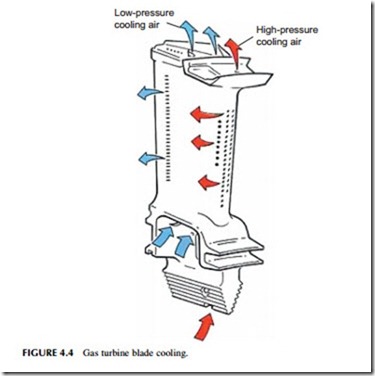GAS TURBINE DEVELOPMENT
Efficiency is perhaps the most important operating parameter for all gas turbine operations. In aero engines, higher efficiency equates to lower fuel costs. Similarly in the power industry, higher efficiency leads to a lower unit cost for elec- tricity generation. Efficiency is important from an environmental perspective too, because the more efficient a gas turbine–based power plant is at generating electricity, the less carbon dioxide and other atmospheric pollutants the power plant will create for each unit of electricity it produces.
As a consequence, the main focus of gas turbine development over the past 20 years had been primarily aimed at increasing efficiency. Overall, efficiency will depend on the efficiency of both the compressor and the turbine, but with both of these now highly efficient, the main means available to gas turbine designers to improve efficiency are by increasing temperature and pressure of the gas entering the turbine (i.e., heat engine) stage of the unit.
The engine compression ratio (the amount by which the compressor increases the inlet air pressure) is one variable available to designers to modify as they seek higher efficiency, but the chosen ratio is generally an optimum for a particular design rather than the highest possible. As already noted, compressor design has reached a high level of sophistication and modern compressors can deliver whatever pressure is required within the stationary gas turbine range of 15:1 to 30:1 at high efficiency.
The design of the turbine stage has also reached a very high level of technical sophistication, with the shapes of the rotating blades and the stationary vanes (sometimes called nozzles) optimized using computer modeling. Thus, the only major variable still open to improve overall efficiency is turbine inlet gas temperature.
Gas turbine combustors are capable of delivering gas at higher temperatures that are currently in use, but the maximum temperature that can be exploited is limited by the performance of the materials employed in the early stages of the gas turbine. Inlet temperatures at the first stages of gas turbines have risen steadily, from around 900 oC in 1967 to 1425 oC in 2000 and 1600 oC in 2010. Efforts to raise temperatures further are underway and a Japanese pro- gram is aiming to achieve 1700 oC in the near future.
Such high temperatures place extreme demands on the materials used in turbine construction, which have to withstand these extreme conditions. The turbine blades, the vanes that control air flow from one set of blades to the next, and other hot-gas-path components are commonly made from nickel-based alloys cast in single crystal form to increase their resistance to deformation or fracture. However, these alloys start to soften at anywhere between 1200 oC and 1400 oC. To render them capable of withstanding higher temperatures they are coated with a ceramic thermal barrier coating (TBC) comprising a material (often based on zirconia) with a low thermal conductivity. On its own, this TBC will not prevent the components from reaching the temperature of the inlet gases so the blades and other components must also be cooled internally by pumping air or steam through channels within them.
Air cooling requires hot air that is “stolen” from a later stage of the turbine. This has the effect of lowering overall efficiency but is simpler to design. In a combined cycle plant steam can be taken from the steam generator and used for cooling. This involves a smaller efficiency penalty but is more complex and can have an effect on overall plant flexibility. See Figure 4.4 for a diagram of gas turbine blade cooling.
While greater efficiency has been a primary goal for modern gas turbine manufacturers, another that has come to prominence since the beginning of the 21st century is flexibility. Flexibility is most important for large, high- efficiency combined cycle plants. Smaller, open cycle gas turbines can
generally be operated flexibly with little penalty. The goal of flexible operation is to be able to maintain good efficiency at part load as well as full load, and to be able to change load quickly. To achieve this, many involve sacrificing the ultimate level of efficiency. Flexible operation for combined cycle power plants will be examined in more detail later in the chapter.
